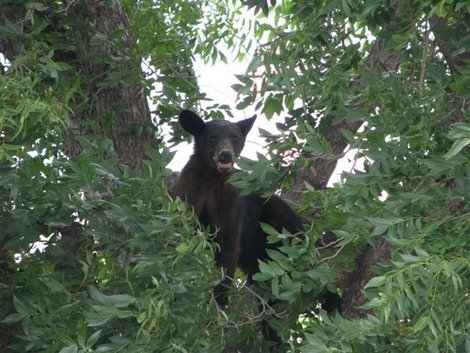
With the number of black bears in Val Verde County, Texas, on the rise, expect more interactions between bears and people, one state biologist says. Texas Parks and Wildlife Department Wildlife Biologist Sylvestre Sorola earlier this week helped capture and relocate a young male black bear that wandered into a residential neighborhood in south Del Rio.
Sorola said encounters like the one earlier this week are possible now because black bears are re-colonizing traditional ranges in south and west Texas, areas from which black bears were extirpated in the mid-20th century.
The biologist said that sightings in Val Verde County began to rise in the 1980s and said those bears probably came to the area from thriving black bear populations in the Sierras del Carmen and the Sierras del Burro, the mountains in northern Coahuila that contain the distinctive “Sleeping Lady” formation west of Del Rio. Sorola said the bears from northern Mexico first established breeding populations in Big Bend National Park in far west Texas and have also returned to the Trans-Pecos, including Val Verde County.
Sorola said a small breeding population of black bears has gained a foothold in remote areas of the Pecos River in Val Verde County and said the young male black bear who wandered into Del Rio Monday and Tuesday could have been a bear wandering south from that population.
Sorola also stressed that while encounters between human beings and bears are likely to continue, even increase, the stress of those encounters can be reduced by the following of a few simple rules.
“Bears are not generally aggressive towards people, with the exception being a sow with cubs,” Sorola said.
He said it is important to remember that black bears are considered a threatened species in Texas and as such, cannot simply be shot on sight.
If a bear becomes a nuisance by raiding garbage cans or a problem by killing pets or livestock and behaving in other threatening ways, it can be removed, as was the bear in south Del Rio.
A bear may be killed, but only as a last resort, Sorola said.
Sorola said bears are omnivores, which means they will eat just about anything they can find, but that much of their diet consists of vegetative matter, including mesquite beans and prickly pear “tunas,” as well as insects and small rodents like ground squirrels.
Persons encountering a bear in town – perhaps going through trash cans or raiding a pet’s food bowl – should go back into their homes and call the police department, Sorola said. The law enforcement officers will contact the biologist and game wardens, Sorola said.
7/1/2018
When was this article published. My neighbors in Val Verde County think they are seeing signs of a Black Bear in the area. Thank you.
Beverly
Beverly, that part of Texas has black bears (all the time).